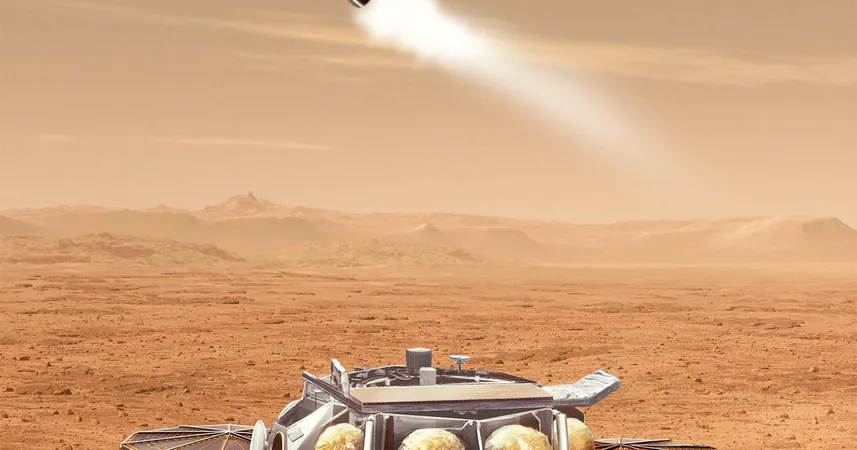
NASA Shifts Focus to Cost-Effective Mars Sample Return Mission Options
2025-01-07
Author: Jia
NASA recently announced a strategic pivot to explore two alternative approaches for its ambitious Mars Sample Return mission, following an independent review indicating costs could soar up to a staggering $11 billion. NASA Administrator Bill Nelson disclosed this crucial decision, emphasizing the urgency to lower expenses and expedite the mission timeline.
Two Viable Options on the Table
The first option involves a streamlined design utilizing the same "sky crane" landing system that successfully deployed the Curiosity and Perseverance rovers. This approach would include a compact sample collection spacecraft, a smaller rocket for launching samples into Martian orbit, and collaboration with the European Space Agency (ESA) to return the samples to Earth. Estimated costs for this option range from $6.6 billion to $7.7 billion, with a potential return timeline between 2035 and 2039, contingent on Congressional funding.
The second option proposes a partnership with private aerospace companies like SpaceX or Blue Origin, leveraging their heavy-lift capabilities to provide a spacecraft that could land on Mars and deliver the necessary equipment for sample collection. Similarly, this option expects to retrieve Martian samples by the mid to late 2030s.
Both alternatives would employ a radioisotope thermoelectric generator (RTG) instead of solar power, safeguarding the spacecraft from the planet’s notorious dust storms while maintaining the temperature of the solid propellant in the Mars Ascent Vehicle (MAV).
Aiming for a 2026 Decision
Nelson stated, “NASA is going to explore two potential options, architecture possibilities.” The decisive choice regarding which alternative to pursue is projected for 2026. This timeline offers the upcoming U.S. administration a robust set of options from which to choose.
Notably, Nelson highlighted the importance of ensuring that the U.S. retains its leadership in space exploration. He drew attention to China's plans for its own sample return mission, describing it as a "grab-and-go" project, contrasting it with NASA's meticulous and scientifically rigorous processes.
Perseverance Rover Samples Hold Key to Mars' Past
At the heart of this endeavor is the NASA Perseverance rover, which landed in February 2021 in Jezero crater—a former lakebed that could harbor traces of ancient microbial life. "The samples will provide a history of what Mars was like millions of years ago when there was water," Nelson added. This research could potentially unveil the existence of life on the red planet millions of years in the past.
Funding Challenges Ahead
Currently, the Senate has allocated $200 million for the Mars Sample Return mission in its fiscal 2025 budget, while the House projects a higher funding level of $600 million. Nelson stressed that to adhere to the timeline and objectives, NASA will need a minimum of $300 million in final budget approvals and possibly more if an expedited return is desired.
An independent review in September 2023 had previously labeled the original mission plan as unfeasible, determining that it would cost significantly more than anticipated and not reach fruition until after 2040. Following this, NASA re-evaluated its mission architecture in April, calling for innovative proposals to reduce costs and maximize the potential to bring Martian samples back sooner.
As NASA continues to navigate these changes, the world watches closely, poised for groundbreaking discoveries that could redefine our understanding of life beyond Earth. Will we finally get a glimpse of Martian history, or is NASA's mission doomed to be caught in a cycle of planning and funding challenges? Stay tuned!

 Brasil (PT)
Brasil (PT)
 Canada (EN)
Canada (EN)
 Chile (ES)
Chile (ES)
 Česko (CS)
Česko (CS)
 대한민국 (KO)
대한민국 (KO)
 España (ES)
España (ES)
 France (FR)
France (FR)
 Hong Kong (EN)
Hong Kong (EN)
 Italia (IT)
Italia (IT)
 日本 (JA)
日本 (JA)
 Magyarország (HU)
Magyarország (HU)
 Norge (NO)
Norge (NO)
 Polska (PL)
Polska (PL)
 Schweiz (DE)
Schweiz (DE)
 Singapore (EN)
Singapore (EN)
 Sverige (SV)
Sverige (SV)
 Suomi (FI)
Suomi (FI)
 Türkiye (TR)
Türkiye (TR)
 الإمارات العربية المتحدة (AR)
الإمارات العربية المتحدة (AR)